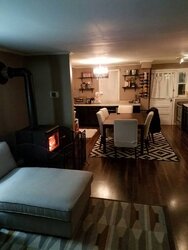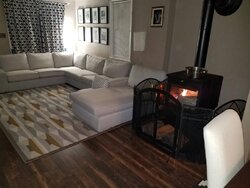Hi Folks,
I'm looking for some real world advice on a replacement, non-cat stove that is 'friendly' for 24/7 burning; while working full time hours. We're usually away from the house anywhere from 8-10 hours a day during the work week and I need a stove that is going to easily spark back up upon return while delivering the BTUs throughout a good chunk of the time away.
I am considering stoves in the 2-3 cubic foot range - there is a local PE dealer not too far away and they usually put on some pretty good sales before the season begins.
House itself isn't that big...about 1000 sq ft on the main level to heat and another 600 or so upstairs. My current stove is centrally located in the middle of the house on the main level and heats alright when I am home to keep it fed with splits....it is a PE Vista. It gets somewhat cold here (-20 Celsius not uncommon in January and February).
The local dealer basically told me they won't sell me a Summit - I am hesitant to go for the Super 27 at 2.2 cubic feet. For you folks with stoves that are around 2 to 2.5 cubic feet, are you able to easily burn 24/7 with them? I'm leaning towards a Summit sized stove given the fact that I can always build smaller fires. Burning only hardwood here. Also, due to exceptional draft issues, I get no where near the burn times the Vista states...more like 3-4 hours of OK heat.
Any thoughts truly appreciated - thanks
I'm looking for some real world advice on a replacement, non-cat stove that is 'friendly' for 24/7 burning; while working full time hours. We're usually away from the house anywhere from 8-10 hours a day during the work week and I need a stove that is going to easily spark back up upon return while delivering the BTUs throughout a good chunk of the time away.
I am considering stoves in the 2-3 cubic foot range - there is a local PE dealer not too far away and they usually put on some pretty good sales before the season begins.
House itself isn't that big...about 1000 sq ft on the main level to heat and another 600 or so upstairs. My current stove is centrally located in the middle of the house on the main level and heats alright when I am home to keep it fed with splits....it is a PE Vista. It gets somewhat cold here (-20 Celsius not uncommon in January and February).
The local dealer basically told me they won't sell me a Summit - I am hesitant to go for the Super 27 at 2.2 cubic feet. For you folks with stoves that are around 2 to 2.5 cubic feet, are you able to easily burn 24/7 with them? I'm leaning towards a Summit sized stove given the fact that I can always build smaller fires. Burning only hardwood here. Also, due to exceptional draft issues, I get no where near the burn times the Vista states...more like 3-4 hours of OK heat.
Any thoughts truly appreciated - thanks





